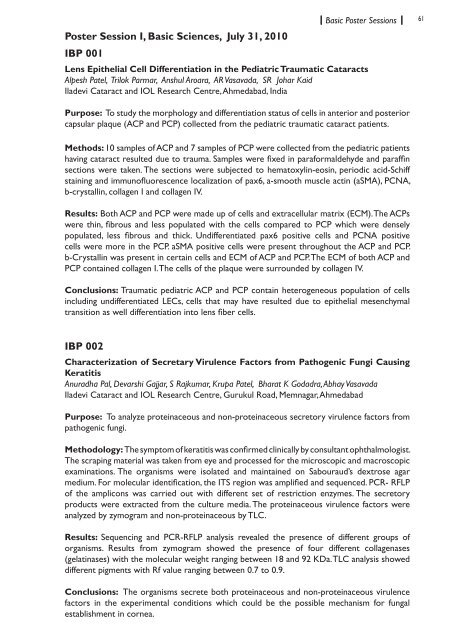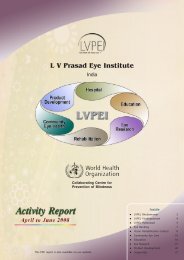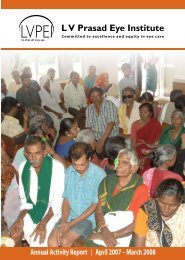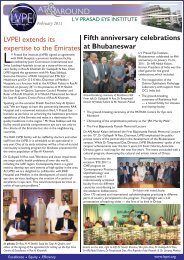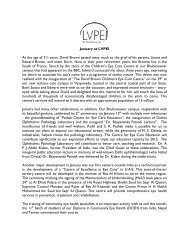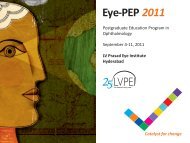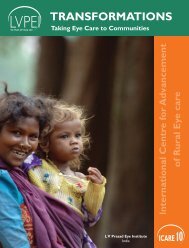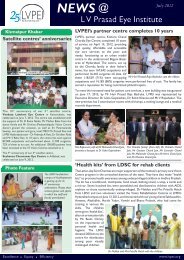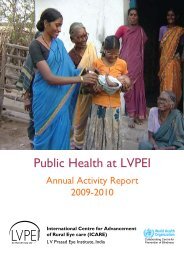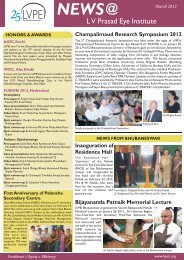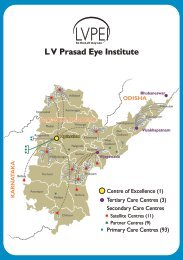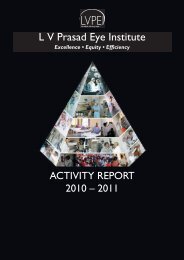IERG Abstracrt Book.indd - LV Prasad Eye Institute
IERG Abstracrt Book.indd - LV Prasad Eye Institute
IERG Abstracrt Book.indd - LV Prasad Eye Institute
Create successful ePaper yourself
Turn your PDF publications into a flip-book with our unique Google optimized e-Paper software.
Basic Poster SessionsPoster Session I, Basic Sciences, July 31, 2010IBP 001Lens Epithelial Cell Differentiation in the Pediatric Traumatic CataractsAlpesh Patel, Trilok Parmar, Anshul Aroara, AR Vasavada, SR Johar KaidIladevi Cataract and IOL Research Centre, Ahmedabad, India61Purpose: To study the morphology and differentiation status of cells in anterior and posteriorcapsular plaque (ACP and PCP) collected from the pediatric traumatic cataract patients.Methods: 10 samples of ACP and 7 samples of PCP were collected from the pediatric patientshaving cataract resulted due to trauma. Samples were fixed in paraformaldehyde and paraffinsections were taken. The sections were subjected to hematoxylin-eosin, periodic acid-Schiffstaining and immunofluorescence localization of pax6, a-smooth muscle actin (aSMA), PCNA,b-crystallin, collagen I and collagen IV.Results: Both ACP and PCP were made up of cells and extracellular matrix (ECM). The ACPswere thin, fibrous and less populated with the cells compared to PCP which were denselypopulated, less fibrous and thick. Undifferentiated pax6 positive cells and PCNA positivecells were more in the PCP. aSMA positive cells were present throughout the ACP and PCP.b-Crystallin was present in certain cells and ECM of ACP and PCP. The ECM of both ACP andPCP contained collagen I. The cells of the plaque were surrounded by collagen IV.Conclusions: Traumatic pediatric ACP and PCP contain heterogeneous population of cellsincluding undifferentiated LECs, cells that may have resulted due to epithelial mesenchymaltransition as well differentiation into lens fiber cells.IBP 002Characterization of Secretary Virulence Factors from Pathogenic Fungi CausingKeratitisAnuradha Pal, Devarshi Gajjar, S Rajkumar, Krupa Patel, Bharat K Godadra, Abhay VasavadaIladevi Cataract and IOL Research Centre, Gurukul Road, Memnagar, AhmedabadPurpose: To analyze proteinaceous and non-proteinaceous secretory virulence factors frompathogenic fungi.Methodology: The symptom of keratitis was confirmed clinically by consultant ophthalmologist.The scraping material was taken from eye and processed for the microscopic and macroscopicexaminations. The organisms were isolated and maintained on Sabouraud’s dextrose agarmedium. For molecular identification, the ITS region was amplified and sequenced. PCR- RFLPof the amplicons was carried out with different set of restriction enzymes. The secretoryproducts were extracted from the culture media. The proteinaceous virulence factors wereanalyzed by zymogram and non-proteinaceous by TLC.Results: Sequencing and PCR-RFLP analysis revealed the presence of different groups oforganisms. Results from zymogram showed the presence of four different collagenases(gelatinases) with the molecular weight ranging between 18 and 92 KDa. TLC analysis showeddifferent pigments with Rf value ranging between 0.7 to 0.9.Conclusions: The organisms secrete both proteinaceous and non-proteinaceous virulencefactors in the experimental conditions which could be the possible mechanism for fungalestablishment in cornea.


